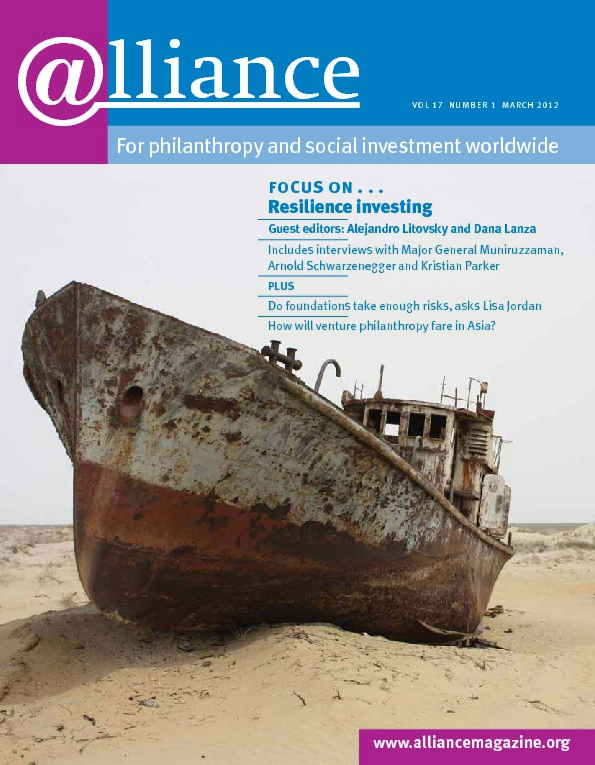Recently, I was talking to a venture capitalist who is setting up a new foundation. ‘In the first half of the life of a venture capitalist,’ he said, ‘I expect 70 per cent of my investments to fail. In the second half I expect 70 per cent to succeed. What is your failure rate?’ How often do we ask ourselves ‘what is our failure rate?’ Unfortunately, I had and still have no answer. Risk is perhaps the most poorly defined concept within the world of philanthropy. In turbulent times such as these, the important role of risk in philanthropic practice needs greater exploration.
In research and development for new products and in the hard sciences, risk is a well-respected companion in every part of the process. Failure is the number one learning tool. Among foundations, only on the investment side is risk analysed. And failure is to be avoided as it means less money for the foundation.
While we are not great at defining risk, we like to talk of innovation. But innovation requires risk and experimentation. So how do we define risk? In the UK, foundations of a certain size are required to report on five categories of risk, relating to governance, operations, finance, environmental and external factors, and legal compliance. The UK Charity Commission defines risk as ‘the uncertainty surrounding events and their outcomes that may have a significant impact, either enhancing or inhibiting any area of a foundation/charity’s operation’. In the view of Stephen Pittam, secretary of the Joseph Rowntree Charitable Trust, the interesting thing about this definition is the fact that uncertainty could enhance a foundation’s operation. When we do focus on risk, we usually focus on mitigating it.
I believe taking risks is an inherent responsibility of organized philanthropy. A big part of our value added to society is to use private money to try to solve intractable problems; to dare to finance dialogue on things that are most often left unspoken; to experiment with better health or education delivery systems; to encourage pioneering and often lonely voices in the arts. If we fail, we have not wasted public money or sacrificed another important line of social spending. Barry Gaberman, a long-time vice president of the Ford Foundation, noted in Alliance that one of the attributes of organized philanthropy is ‘the ability to take risks, to grapple with sensitive issues the public sector will shy away from’. The question is, do we?
The answer to this question is unclear and rarely explored. The sector has a good understanding of financial risk and a number of forums in which investment officers can discuss and calculate risk. On the programme side, however, we have no forums where risk can be discussed nor tools to help us make calculated risks, and we rarely use the tools we have such as evaluation to help us understand the degree to which we have succeeded or failed.
Sadly, we are not in the habit of publishing our failures. The Bernard van Leer Foundation (BvLF) ceased financing a particular migrant community in Israel because our programmes were not serving children as well as we had hoped, in part due to internal conflicts within the migrant populations. We have never put this story into the public domain, though many other foundations and the Israeli government continue to try to serve the same population. There are countless reasons why foundations do not share failures, including, as in this case, the need to avoid further marginalizing vulnerable populations. But are we fulfilling our responsibility to society when we do not share our failures?
In the interest of creating spaces to discuss failure and risk, the EFC’s annual conference in Belfast in June will include a session called ‘Risky Business’. Here a group of foundations will explore risk as it pertains to foundation programmes, and the relationship between risk, mission and innovation, and map foundations across Europe on a risk continuum. We hope to be able to illuminate how foundations talk about risk, what constitutes risky behaviour, and which risks are worth the consequences of failure. Risk is perceived differently depending upon what role one has in a foundation. As an executive director I will focus on reputational risk, while a programme officer might focus on risks associated with a strategic approach to a goal.
Instead of focusing on mitigating risk, I hope foundation executives, trustees and officers will understand that risky behaviour is part and parcel of a foundation’s DNA. We should have a greater appetite for risk, just like that venture capitalist, and learn to embrace failure. One day we should know how to answer the question ‘what is your failure rate?’
Lisa Jordan is executive director of the Bernard van Leer Foundation. Email Lisa.Jordan@bvleerf.nl






Comments (0)